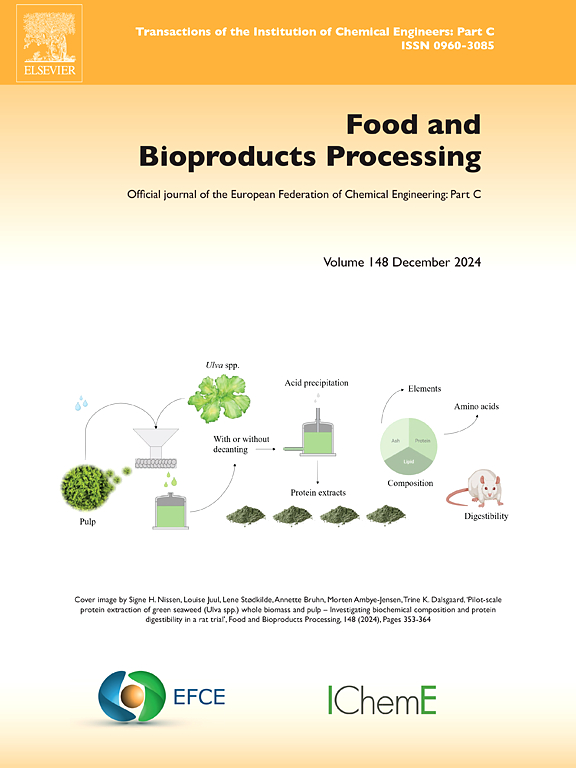对鲍鱼多糖的组成、分离纯化及生物活性进行了综述
IF 3.4
2区 农林科学
Q2 BIOTECHNOLOGY & APPLIED MICROBIOLOGY
引用次数: 0
摘要
鲍鱼多糖是从鲍鱼中提取的一种多糖物质,主要来源于鲍鱼的内脏,具有多种生物活性。它们主要由甘露糖、葡萄糖、半乳糖、焦糖和醛酸等多种单糖组成。有些鲍鱼多糖还含有硫酸盐基团。21世纪以来,随着海洋工业的发展,海洋多糖特别是水生动物多糖的研究进展迅速。鲍鱼多糖作为重要的海洋动物源性多糖之一,在提取、制备和纯化等方面都取得了重大进展,并在体内和体外实验中显示出抗氧化、抗肿瘤、抗凝血、抗病毒、抗菌和抗炎等多种生物活性。这些生物活性特性表明鲍鱼多糖在功能产品和药物的研究和开发方面具有广阔的前景。本文就鲍鱼多糖的种类、组成、制备、分离纯化及生物活性等方面的研究进展进行综述,以期为鲍鱼多糖的进一步研究提供参考。本文章由计算机程序翻译,如有差异,请以英文原文为准。
A comprehensive overview of the composition, isolation, purification, and biological activities of abalone polysaccharides
Abalone polysaccharides are a type of polysaccharide substance extracted from abalones, mostly from their internal organs, which possess various biological activities. They are mainly composed of multiple monosaccharides such as mannose, glucose, galactose, fucose, and uronic acids. Some abalone polysaccharides also have sulfate groups. Since the 21st century, with the advancement of the marine industry, research on marine polysaccharides, particularly those derived from aquatic animals, has progressed rapidly. As one of the critical marine animal-derived polysaccharides, abalone polysaccharides have made significant progress in the extraction, preparation, and purification processes, and have demonstrated various biological activities in both in vivo and in vitro experiments, including antioxidation, anti-tumor, anticoagulation, antiviral, antibacterial, and anti-inflammatory properties. These bioactive properties suggest that abalone polysaccharides have broad prospects in the research and development of functional products and pharmaceuticals. Based on current research results, this review discusses the types, composition, preparation, separation, purification, and biological activities of abalone polysaccharides, aiming to provide references for future research.
求助全文
通过发布文献求助,成功后即可免费获取论文全文。
去求助
来源期刊

Food and Bioproducts Processing
工程技术-工程:化工
CiteScore
9.70
自引率
4.30%
发文量
115
审稿时长
24 days
期刊介绍:
Official Journal of the European Federation of Chemical Engineering:
Part C
FBP aims to be the principal international journal for publication of high quality, original papers in the branches of engineering and science dedicated to the safe processing of biological products. It is the only journal to exploit the synergy between biotechnology, bioprocessing and food engineering.
Papers showing how research results can be used in engineering design, and accounts of experimental or theoretical research work bringing new perspectives to established principles, highlighting unsolved problems or indicating directions for future research, are particularly welcome. Contributions that deal with new developments in equipment or processes and that can be given quantitative expression are encouraged. The journal is especially interested in papers that extend the boundaries of food and bioproducts processing.
The journal has a strong emphasis on the interface between engineering and food or bioproducts. Papers that are not likely to be published are those:
• Primarily concerned with food formulation
• That use experimental design techniques to obtain response surfaces but gain little insight from them
• That are empirical and ignore established mechanistic models, e.g., empirical drying curves
• That are primarily concerned about sensory evaluation and colour
• Concern the extraction, encapsulation and/or antioxidant activity of a specific biological material without providing insight that could be applied to a similar but different material,
• Containing only chemical analyses of biological materials.
 求助内容:
求助内容: 应助结果提醒方式:
应助结果提醒方式:


